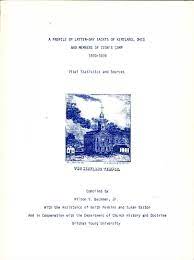Articles/Essays – Volume 17, No. 1
More on Kirtland | Milton V. Backman, Jr., A Profile of Latter-day Saints of Kirtland, Ohio, and Members of Zion’s Camp 1830-1839: Vital Statistics and Sources, and Anne B. Prusha, A History of Kirtland, Ohio
For many, Kirtland is viewed as the genesis of Mormonism as a viable church and perhaps the best test case of Joseph Smith’s prophetic claims and personal integrity. As such, interest in the history of Mormon Kirtland is not likely to wane soon. Two recent additions are diverse, not only in relationship to each other, but also in comparison to previous work on Kirtland.
Milton Backman’s A Profile of Latter day Saints of Kirtland, Ohio, . . . is an important contribution to our knowledge of Kirtland and will be a primary source of data for the serious scholar for years to come. His work reflects the increased interest in quantitative data and particularly genealogical records as primary-data sources. His study is not, however, devoted to settling issues, but is primarily a careful enumeration of names and vital statistics of Mormon families most likely living in Kirtland sometime during the decade of the 1830s (80 of the 165 pages), lists of participants in Zion’s Camp and Kirtland Camp (13 pages), shareholders of the Kirt land Safety Society (2 pages), and a very useful listing of the Kirtland land and tax records by Keith Perkins (33 pages).
Anyone seeking an accurate estimate of population for Kirtland or the Church during this period is aware of the many difficulties. No complete Church member ship records exist and, as Backman notes, there are many visitors and temporary residents in addition to the usual problems of duplicate names, misspellings, etc. The result of Backman’s study is clearly the most complete and accurate list available. Back man acknowledges that these lists and vital statistics are not complete or without error. They sometimes raise additional questions themselves. An example is the increase in the number of Saints in Kirtland and vicinity from 100 to 500 within two years of the departure of some 2,000 members for Missouri.
Anyone seriously interested in events surrounding Mormon Kirtland will of necessity consult this source and be indebted to Milton Backman, Keith Perkins, and others for their painstaking efforts in providing us a clearer window through which we may view Kirtland. It is, how ever, left to others to use these data to clarify and reconcile the many ambiguities and controversies which surround Joseph Smith and the Church in Mormon Kirtland.
Anne Prusha’s A History of Kirtland, Ohio is an equally ambitious task as she seeks to provide the reader with a survey of Kirtland’s history from about 1810 to 1970. Interest in this work on the part of Mormon historians is, of course, the opportunity to place Mormon Kirtland in con text—a view of soon-to-be Mormon con verts, supporters, or detractors both before and after the decade of intense Mormon activity. Unfortunately, the results are not particularly satisfying.
Her survey of Mormon Kirtland stems primarily from four standard sources, the most recent being Max Parkin’s 1966 “Conflict at Kirtland . . .”; and Mormon Kirtland accounts for almost one-third of the book, leaving only ten pages for the last half of the nineteenth century and fifteen pages for the first seventy years of the twentieth-century. Begun as a master’s thesis at Kent State University, this brief book provides an overview of Kirtland’s history, but for one at the cutting edge of Mormon history it does not offer, nor claim to offer, depth or new insight into Mormon Kirtland.
A Profile of Latter-day Saints of Kirtland, Ohio, and Members of Zion’s Camp 1830-1839: Vital Statistics and Sources, compiled by Milton V. Backman, Jr., 2nd ed. rev. (Provo, Utah: Brigham Young University, 1983), 165 pp.
A History of Kirtland, Ohio, by Anne B. Prusha (Mentor, Ohio: Lakeland Community College Press, 1982), 130 pp.


 Back to full Issue
Back to full Issue

